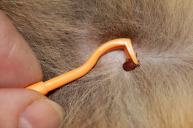Earlier this year, the DuPage Forest Preserve went viral for using humans to re-enact the lifecycle of a cicada. The educational materials, which explained the sudden increase in the cicada population, gained millions of views, widespread shares, and even recognition from late-night comedian Stephen Colbert. And this week, they recreated some of that magic with a new public service announcement about ticks.
In the video, two DuPage Forest Preserve employees wear homemade tick costumes as they relay tick factoids. "We're ticks! Of course, people think we're insects, but we're actually arachnids because we have eight legs," says one. And the other says, "We're ticks! Of course, we hang out in tall grass and piles of leaves."
You get the idea. It's a now standard TikTok and Reel form. However, the video goes off the rails when one of the two women breaks character — or maybe, gets too into character — whichever.
"We're ticks! Of course, you could avoid us by walking in the middle of the trail," says one until the other interrupts, "No! We don't want anyone to know that!" But she continues to reveal helpful tips about avoiding ticks, such as wearing EPA-approved bug spray. "No! Why did you tell them our weakness?!"
View this post on Instagram
How to protect yourself from ticks
According to the DuPage Forest's website, there are a variety to avoid ticks during ticks season, which occurs between March and October all over Illinois, but especially in the Chicagoland area.
The preserve recommends that you wear light-colored clothing whenever you venture out into the woods. The reason is you'll have an easier time spotting a tick's dark body than if you wore dark clothes.
As they said in the video, they also recommend applying insect repellant containing 20 to 30 percent DEET to your clothing. Then, throw your clothes into the dryer on high heat when you get home for about 30 minutes to burn those little bloodsuckers.
And if you find a tick on your body, they recommend using a pair of tweezers to grab it — you should grab it as close to the skin as possible — and then slowly but firmly pull it straight out. Afterward, clean the area and your hands thoroughly.




